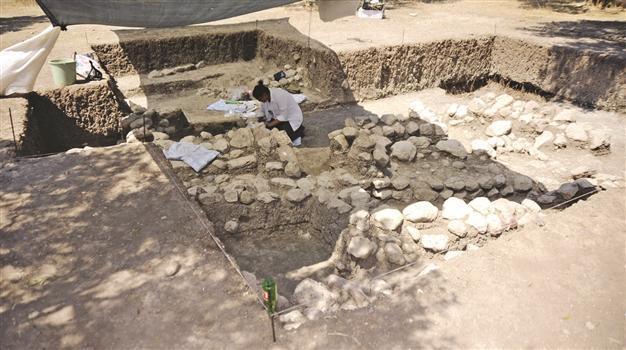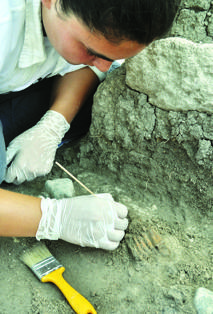Tomb reveals burial methods of ancient age
ÇANAKKALE - Anadolu Agency

The tomb was discovered for the first time in Smitheus, where prehistoric settlement excavations began in 2004. AA photo
Excavations at Apollon Smintheus, located in the northwestern province of Çanakkale’s Ayvacık district, have unearthed a 7,000-year-old tomb.
Headed by Professor Coşkun Özgünel, the excavations are being carried out with scientific consultancy from the head of Çanakkale Onsekiz Mart University’s (ÇOMÜ) Archaeology Department, Professor Turan Takaoğlu.
Takaoğlu said the tomb, which is a significant finding for the region’s archaeological history, provided crucial information about the burial methods in the region during that ancient era.
He said bodies were laid in the tombs in the fetal position. “Ceramics were put next to the bodies as gifts. The tombs were covered with stones randomly. The tombs were discovered for the first time in Smitheus, where prehistoric settlement excavations began in 2004,” he said.
The professor said the tombs would help them fill in the gaps in the region’s archaeology.
 Apollon Smintheus
Apollon SmintheusThe Apollon Smitheus Temple is located in the Bahçeleriçi area, in the skirts of a valley between the northwest and northeast of Gülpınar village in Ayvacık, which was known as Külahlı in the past.
It was built in the second half of the 2nd century B.C. and was a sacred place in the Troas region. The pseudodipteral style of the architect Hermogenes was used in the temple’s design. There are eight columns at both the front and back of the temple and 14 columns along its sides.
The temple contains three chambers, including a pronaos (sacred front chamber), a naos (sacred room) and an opisthodomos (back chamber), as well as the statue of the god Apollon, made by the sculptor Skopas.
According to a book titled “Geographica,” written by famous geographer and traveler Strabo 2,000 years ago, when the Ions came from Greece and surrounded the city, a host of rats came to the surface from underground at night and nibbled their weapons and equipment, which caused the Ions to lose the war. The people of the region then built the temple as a symbol of their appreciation.

 Apollon Smintheus
Apollon Smintheus